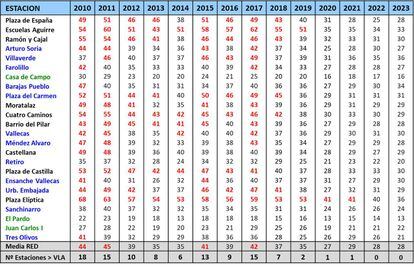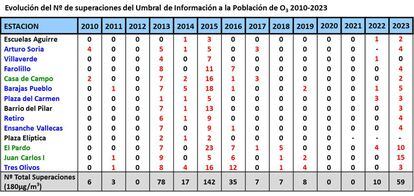Second consecutive year in which Madrid improves air pollution data and manages to comply with European limits for nitrogen dioxide (NO₂) and second year in which the mayor, José Luis Martínez-Almeida, rings bells. “We start 2024 with great news: Madrid has a different air, cleaner, healthier. Today Madrid is an example for Europe,” says a triumphant Almeida in a press release released this Tuesday by the City Council. After years of non-compliance, which led the EU to condemn Spain for the poor results of Madrid and Barcelona, the capital had one NO₂ black spot left: Plaza Elíptica. In 2022, this observatory remained at 40 micrograms per cubic meter (µg/m³), right at the threshold set by the European Union (EU) in his 2008 directive. This 2023, the figure has been lowered to 36 μg/m3. Ecologists in Action celebrates a “real and clearer” data, but reminds the mayor that he is ignoring that the figures for other polluting gases with legislated thresholds, such as tropospheric ozone, the so-called ozone bad, “they are the worst since 2015.” “Overall, the data for 2023 are much worse than what we saw, aggravated by climate change,” says one of his spokespersons, Juan Bárcena.
In the note, the mayor maintains that in 2023 “the best air quality records” in the historical series have been achieved, reducing NO₂ levels “to historic lows” and “maintaining a balance between economic growth and environmental protection.” environment”. “We have shown Europe that our Strategy against pollution and for air quality is a success. The effectiveness of Madrid 360 is undeniable,” the councilor rejoices, stating that “the previous measures were simply ineffective,” in reference to Madrid Central that in his first mayoral campaign he promised to repeal. For Bárcena, however, “the great merit” of Almeida has been precisely “not complying with his program and not having loaded Madrid Central”, despite having made it more lax, “by allowing the entry of 50,000 more polluting cars into the central almond ”.
“Today we can proudly say that we have reversed that situation.” [en referencia a la condena a España de 2022 por los incumplimientos reiterados de la normativa comunitaria] thanks to our Madrid 360 Environmental Sustainability Strategy,” Almeida declares, to which Bárcena, with the data in hand, replies that “the true and great turning point was 2019, with the entry into force of Madrid Central.” As the Ecologistas air quality expert recalls, “if you look at the evolution of the data since 2010, when the limits are applicable, the number of stations that exceeded them has been oscillating from 18 of the 24 existingthe worst figure, to six, with an average of 11. The big jump occurred in 2019, with Madrid Central, when non-compliant stations dropped to two.”
However, in the figures provided by the City Council, “cheap comparisons are made by using 2018 as the base year – the PP returned to power in the capital in June 2018 – ignoring 2019.” In its note, the City Council highlights that Plaza Elíptica has dropped an average of 32% since 2018 and 11% compared to 2022.
It also specifies that the stations that lead the greatest drop in nitrogen dioxide “since 2018 thanks to Madrid 360” are Escuelas Aguirre, which did not comply with 55 μg/m3 and now stands at 33 (-40%). “The Plaza de España station follows in the ranking of the biggest declines. In 2018 it failed to comply with 43 and in 2023 it has registered 28 (-35%). It is followed by Plaza Elíptica, which until 2022 was the black spot for pollution in the capital. If in 2018 it exceeded the board limit to reach 53, it closed the year with 36 (-32.1%),” indicates the City Council.
What affects the most is what happens closest. So you don't miss anything, subscribe.
Subscribe

In any case, Ecologistas does not care who wins the NO₂ reduction medal, whether this or the previous corporation, because “what is truly important is that Madrid's air quality is far from good.” According to official data compiled by Ecologistas, which will soon make its own assessment of the year, in 2023 “the threshold for warning the population of tropospheric ozone levels – 180 μg/m3 for one hour – was exceeded in 12 of the 14 stations that measure it” and, in total, it occurred 59 times, compared to 10 in 2022 and zero in 2021 and 2020. “To find a worse figure, you have to go back to 2015, when there were 142 exceedances.” “We comply with NO₂, but not with tropospheric ozone, which is getting worse and there is no protocol, which Valladolid and Paris do have,” Bárcena emphasizes.
And the most serious thing, in his opinion, is that “we began to comply with it 12 years late and just when the reference values are going to change.” Ecologists recall that the World Health Organization (WHO) has already reduced the threshold to 10 μg/m3 of NO₂ in 2021 and the EU will foreseeably approve a limit of 20 at the beginning of this January. “Only three stations, Casa de Campo, El Pardo and Juan Carlos I are within those values,” highlights Bárcena, to underline that the EU will ask Spain to “reduce” pollution by half “in five or so years.” “The worst thing about complacency is staying there, when the only thing we have achieved is to comply with values that have already become obsolete,” Bárcena laments.

“And looking towards 2024, the challenge is to continue improving,” the mayor launches in his statement, but without announcing new measures. In this sense, Ecologistas reminds you that plan A, prepared by the Government of Manuela Carmena and which is still in force, marked Madrid Central as step one, which would be followed by a drastic reduction of lanes in all the arteries of the city. “They took over Gran Vía, but it stayed there,” says Bárcena, who asks the mayor to urgently set a date for the reform of the capital's other major thoroughfares.
The City Council also highlights, as an example of the “effectiveness of Madrid 360”, that it is the second year in which it is not applied. the anti-pollution protocol since it came into effect in 2015, while in 2017 it was activated for 43 days. But, as happened in 2022, meteorology has contributed decisively to this in 2023. Autumn was extremely humid in the Community of Madrid and there has not been a prolonged anticyclonic situation with thermal inversion and zero wind, which is what generates the famous beret of the capital.
What the mayor and Ecologists do agree on is the same message of gratitude to the people of Madrid. “This achievement would not have been possible without you, who have assumed these policies not only as a norm, but as a lifestyle,” Almeida tells the city's inhabitants. Bárcena also highlights greater awareness and citizen civility.
Subscribe here to our daily newsletter about Madrid.
#Madrid #complies #year #European #limits #nitrogen #dioxide #air